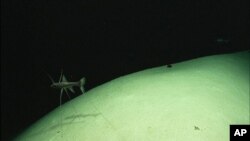Filmmaker and explorer James Cameron is making an 11-kilometer dive to the deepest and most remote spot on the planet - the bottom of the Mariana Trench in the Pacific Ocean. It’s a place of perpetual darkness, near-freezing temperatures, and immense pressures, yet Cameron and many marine scientists expect to find a host of life forms thriving down there.
In his 1989 deep-sea adventure film, The Abyss, director James Cameron used innovative technology to film far below the ocean’s surface.
Now Cameron is using even more innovative technology to dive as far as one can go below the ocean’s surface, to a place visited only once before -- by the two-man crew of the submersible Trieste -- 52 years ago. Cameron is making the nine-hour expedition in a one-man submarine he helped design, and recording ultra-high-definition video of the deep and collecting research samples. During a recent pause in preparations, the director-explorer explained what he hopes to learn from his dive.
"We know very little about the species that live down there. We know little about the distribution of the biological communities. We don't know how these animals have adapted to this unbelievable pressure that exists down there," Cameron said.
The extreme water pressure at the ocean bottom has been compared to the weight of several jumbo jetliners concentrated on one’s body. Any leak in Cameron’s submersible would crush him to death instantly. Yet somehow, a menagerie of bizarre and wonderful animals thrives in this abyss, says Melanie Stiassny, curator of fishes at New York’s American Museum of Natural History.
“Oh, it can get incredibly weird down there! I think some of your listeners may have seen images of the viper fishes and the dragon fishes. Strange, very often black animals with huge fangs and bioluminescent lures and just the most weird-looking animals. Interestingly when you see pictures of them you think ‘Oh my god! It’s a monster!’ They really look like dragons and monsters. But in fact they are really very small. The reason they are very small, or one of the reasons they are very small, is there isn’t much food deep down in the ocean. So everything is very lean and mean. It’s all about being able to locate that precious piece of prey,” Stiassny said.
The life forms that inhabit the profound deep have devised intriguing ways to get food. The fins of the so-called tripod fish for example, have evolved into long filament-like “legs,” which it uses to lift itself above the ooze of the sea floor. When it senses vibrations caused by the movement of another animal nearby, it strikes.
“Other organisms make these giant nets of mucus, kind of like snot, that allow them to collect all the particulate matter that comes down,” said Peter Girguis, who conducts his own deep-sea research using unmanned vehicles. The Harvard University oceanographer studies the life forms that live near the hydrothermal vents on the ocean floor that spew sulfur and other chemicals directly from the earth’s mantle. Almost all animals and plants get their energy at least indirectly from the sun. But these exotic organisms live on chemical energy alone.
“What is interesting, though, is for those of us who live on land, the deep ocean is really hostile. So from our point of view it’s extreme. From the point of view the animals that live there, it’s home,” Girguis said.
Visiting those extreme habitats is extremely expensive, whether it’s using remotely operated vehicles such as the ones Girguis uses, or in manned submersibles such as the Trieste or James Cameron’s Deep Sea Challenger. Manned expeditions are also extremely dangerous. But Girguis believes there is a powerful advantage to direct human observations.
If I gave you a chance to go into the Grand Canyon and you could see with your own two eyes how the bighorn sheep grazed on particular foods or what the distribution of plants and animals were in the canyon relative to the river, you’d be able to much more quickly and viscerally understand that ecosystem. That is the big advantage of a human-occupied vehicle,” Girguis said.
Deep-sea expeditions like James Cameron’s advance our scientific knowledge of undersea habitats and unique geological sites like the Mariana Trench. They also give armchair adventurers a thrill. But Melanie Stiassny of the American Museum of Natural History says the main value of these expeditions is that they raise public awareness of the Earth’s final frontier.
“If people see something and are excited by it, they’re going to be much more inclined to be concerned about conserving it and making sure we look after it properly,” Stiassny said.
News
Pacific Ocean Abyss is Dark, Cold - and Maybe Teeming with Life






